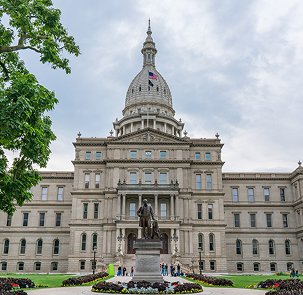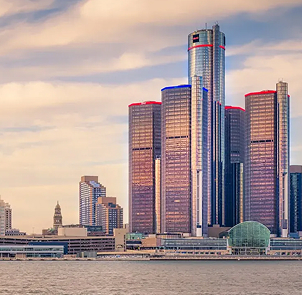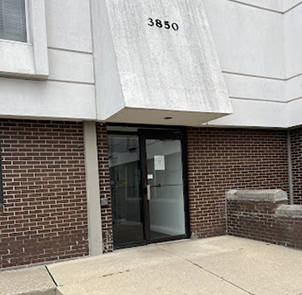- News
- Michigan’s Auto Insurance Dilemma: Why Are Premiums So Absurdly High?
Michigan’s Auto Insurance Dilemma: Why Are Premiums So Absurdly High?

As you probably know, despite widely publicized efforts a couple of years ago to cut the premium costs we all pay, Michigan’s car insurance rates are still the highest in the nation. In fact, with average annual premiums approaching $4,000, Michiganders continue to pay more for car insurance than all other American drivers according to a MarketWatch report published just last month. In case you’re interested in moving elsewhere to save money on car insurance, some states you might wish to avoid are Connecticut ($2,999), Florida ($2,947), New York ($2,783), and Louisiana ($2,783). On the other side of the coin, the report notes that states with the lowest yearly premiums are Maine ($964), Ohio ($1,027), Vermont ($1,056), Idaho ($1,069), and Virginia ($1,142).
So, what exactly causes Michigan’s car insurance costs to be so high compared to literally every other state? There are several factors contributing to that situation. Let’s look at them one at a time… and then we’ll describe a few steps you can take to help keep your own car insurance costs under control.
Reason #1: Michigan’s No-Fault Insurance Law (Particularly Unlimited PIP Benefits)
No-Fault car insurance has been mandatory in Michigan since 1973. As we pointed out earlier this year, rather than saving money for Michigan drivers, No-Fault policies were intended to reduce the strain on the legal system by eliminating subjecting every car accident to litigation in order to determine who was responsible for damages (such as car repair costs, medical bills, lost wages, rehabilitation charges, etc.). With our specific brand of no–fault insurance, Michigan (unlike most states) requires that your own insurance company pick up the tab for your car repairs and personal injury protection (PIP) benefits following an accident – regardless of who was to blame for the crash. And part of the state’s original No-Fault plan included providing unlimited lifetime benefits for people whose injuries were so severe that they required long-term care or were unable to return to work.
But while it’s certainly a desirable aspect of Michigan’s No-Fault insurance system, all that coverage does cost a lot of money. So, a couple of years ago, the state’s No-Fault law was modified to make it possible for you to choose something less than unlimited PIP benefits to save on premium costs – but you do so at your own peril! Under the current law, you’re permitted to limit your PIP coverage to as little as $50,000 or completely opt out of PIP coverage depending upon your personal circumstances. But with medical costs continuing to rise significantly, even seemingly minor injuries could get you into deep financial difficulties if you don’t have adequate insurance coverage to protect yourself from today’s out-of-control medical bills and rehabilitation costs. As a result, we continue to strongly encourage our readers to choose unlimited PIP benefits, even though it will cost you more on your car insurance bill.
Since Michigan stands out with its stringent auto insurance laws, it mandates higher minimum coverage limits than most states. While this ensures drivers possess substantial financial security following an accident, these robust requirements naturally translate into heftier insurance premiums.
To drive legally in Michigan, you need to carry significant coverage:
- Bodily Injury Liability: At least $50,000 per person and $100,000 per accident.
- Property Damage Liability: A minimum of $10,000.
- Personal Injury Protection (PIP): Starting from $250,000, with many opting for unlimited coverage to address potential catastrophic medical expenses.
The need for higher coverage directly impacts premium costs. Insurers have to prepare for potentially large payouts, particularly concerning PIP claims. This increased financial risk for insurers necessitates higher premiums for policyholders to ensure that companies can cover possible claims. Contrast this with states like Ohio and Indiana, where minimum coverage for bodily injury stands at a much lower $25,000 per person. These states offer less protection in severe accidents, but their premiums tend to be less expensive due to lower coverage limits.
For Michigan drivers, there’s a clear trade-off: paying more upfront in insurance costs provides greater peace of mind with enhanced protection. While it might strain the wallet initially, the comprehensive coverage assures financial assistance when needed most during severe accidents. Ultimately, Michigan’s high insurance requirements mean a safer buffer against financial burdens post-accident, at the expense of higher out-of-pocket premiums. This system prioritizes safety and readiness, albeit with a higher cost of entry into the roadways.
Reason #2: Michigan’s High Amount of Deer-Car Accidents
Every year, unlucky Michigan drivers have around 50,000 close encounters of the worst kind: accidents between cars and deer. In fact, as we noted in an article discussing this sad situation, Michigan is ranked in the top four states nationally for car-deer collisions. What’s more, Oakland County is ranked second in the state for the number of accidents involving vehicles and errant deer. While most of those incidents are not totally tragic (deer have been known to walk away from many such crashes seemingly unhurt, and people are only rarely injured), they do result in lots of expensive damage to cars, trucks, vans, and RVs. And the costs of necessary repairs – or even replacing vehicles which have been totaled – are covered by insurance companies, which then must pass them on to policyholders in the form of higher premiums across the board.
Reason #3: Michigan’s Huge Number of Uninsured Drivers
Despite our state law requiring drivers to purchase car insurance, you might be shocked to learn that around one of every four drivers don’t do so in Michigan. That’s right – take a good look at the cars around you next time you’re on the road and consider the fact that one out of every four you pass is likely to be uninsured. When there are more uninsured drivers, insurers must shift costs to people who do have insurance to protect themselves from bottom-line losses. In Michigan it’s a catch-22 and a vicious circle combined: high insurance rates make it difficult for some people to afford coverage, and when those people don’t buy coverage, it causes rates to rise for everyone else, which then leads to more people being unable to buy insurance. However, for this reason we always recommend people purchase uninsured (UM) and underinsured (UIM) motorist coverage. This is optional coverage offered by almost every insurer in the state and it will allow you to make a claim for pain and suffering, disfigurement, death, and excess allowable expenses if the negligent driver that caused your crash was uninsured or insufficiently insured.
Reason #4: Michigan’s Infamously Severe Winter Weather
Despite the current trend of temperate weather, Michigan was once again named the worst state of all for winter driving conditions in 2023. Lake-effect snow, poorly maintained roads, the prevalence of black ice, and unsafe drivers, are among the factors that make the Great Lakes State not so great when it comes to driving during the winter months. And because of all that, accidents happen! There’s not much we can do about Michigan weather, but there are some ways you can avoid becoming a sad statistic this winter. First and foremost, don’t text and drive. It’s against state law even to hold a phone when you’re behind the wheel. And, as usual, never get into a car unless you are drug and alcohol-free. Beyond that, be sure to fill your wiper fluid, check the condition of your tire treads, secure your kids in car seats as required by law, and buckle up your own legally-required seat belt, too. . Additionally, you may want to consider getting all weather or even snow tires for your vehicle for Michigan’s winter months.
And Now Here Are Some Ways to Save Money on Car Insurance
Despite all those issues, Michigan is still a great place to live. So rather than moving to Ohio, here are some ideas that you may be interested in make your car insurance costs at least somewhat more tolerable. While we certainly aren’t insurance agents or compelling you to make a decision either way, we are presenting you with information to do with as you please. So, that being said…
Other than shopping around for the lowest priced coverage every year, one time-tested way to cut out-of-pocket insurance costs is to raise your collision and comprehensive deductibles. By essentially “self-insuring” when you agree to accept a higher deductible, you’ll very possibly save quite a bit of money on car insurance. In fact, BankRate highlights details from an Insurance Information Institute report which states that choosing a $1,000 deductible could cut your premiums by as much as 40 percent. But remember that if you do get into an accident or need to file a comprehensive claim for vandalism or some other road hazard, you’ll be on the hook for whatever deductible amount you’ve chosen.
Another money-saving tip is to check with your insurance agent to verify that the personal information you provided when you purchased your policy is still accurate. One of the factors that might impact your rates is the length of your regular commute to work or school. The more miles you typically drive on your car, the more you’ll generally pay for car insurance. If you’ve changed jobs or are now working at home, you may be able to cut your costs by updating those details. Beyond that, you can ask your agent about what’s included in your “insurance score” – a rating system that uses factors such as your credit report and prior insurance history to help set your premiums and to determine any discounts for which you might be eligible. (By the way, under Michigan law, the insurance score can’t be used to deny you coverage, or to justify canceling or not renewing your policy, though it can impact your payment options or insurance premiums.)
Of course, it goes without saying that being a safe driver helps reduce your car insurance premiums. If you have a history of getting into collisions, driving drunk, or receiving traffic tickets for speeding, running stoplights, or other moving violations, you’ll pay higher insurance costs than drivers without such black marks on their records. You can also take advantage of other opportunities for safe drivers to save money, including “usage-based” discounts where you agree to permit your insurer to monitor your driving habits via electronic tracking devices installed in your car.
You could also choose to own a vehicle that’s less costly to insure. Trade in your accident-prone sports car for a safer sedan, and you’ll likely save some cash. If you own a car that’s popular with thieves, like a rubber-burning Dodge Hellcat or one of the Kias or Hyundais that have been so famously snatched by Tik-Tok-inspired teen pranksters this past year, you can cut insurance costs by buying a model that’s on the list of least-stolen vehicles.
Furthermore, bundling your insurance policies can be a strategic move to reduce these costs while maintaining essential coverage. Here are some of the benefits:
- Discounts on Premiums:
- By combining your auto insurance with homeowners or renters insurance, many companies offer attractive discounts. These reductions can help alleviate the financial strain of Michigan’s notoriously high rates.
- Simplified Management:
- Keeping all your insurance under one provider streamlines your account management. One bill, one point of contact — it’s convenience paired with savings.
- Long-term Savings:
- Insurers value customer loyalty and often provide bundling discounts that potentially decrease premiums by 10% or more.
As you can see, bundling can help offset these costs without compromising coverage. Here are some tips for maximizing your savings:
- Explore Multiple Offers:
- Don’t settle for the first bundling option you receive. It’s crucial to compare bundled rates with those of separate policies to ensure you’re benefiting financially.
- Prioritize Coverage Needs:
- While reducing premiums is important, maintaining adequate coverage is essential. Adequate protection is crucial in the event of an accident, helping cover medical expenses and loss of income.
By intelligently navigating bundling options, you can potentially lower your auto insurance costs in Michigan while securing the coverage you need.
One Final Idea to Keep in the Back of Your Mind
All that aside, if you ever find yourself in a situation where you’ve been hurt in a car crash, you should consider protecting yourself and the people you love from the high costs of medical bills, lost wages, and long-term care expenses by engaging the services of a trustworthy personal injury attorney at Mike Morse Law Firm. We’ll do our level best to see that you get the compensation you deserve for your injuries, and you never pay a penny until we win your case. So keep our number handy: it’s 855-MIKE-WINS (that’s 855-645-3946) or you can always submit an online request here to learn more about how to get everything you need financially to make up for the pain and suffering you’ve experienced physically.

Content checked by Mike Morse, personal injury attorney with Mike Morse Injury Law Firm. Mike Morse is the founder of Mike Morse Law Firm, the largest personal injury law firm in Michigan. Since being founded in 1995, Mike Morse Law Firm has grown to over 200 employees, served 40,000 clients, and collected more than $1.5 billion for victims of auto, truck and motorcycle accidents. The main office is in Southfield, MI but you can also find us in Detroit, Sterling Heights and many other locations.








